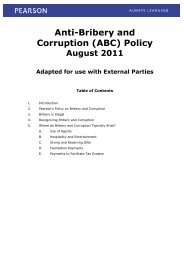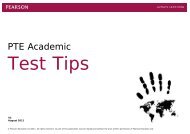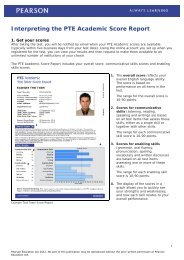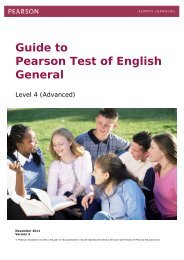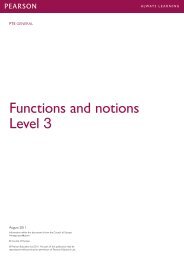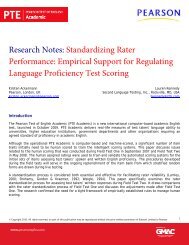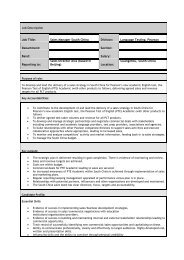Versant English Test: Test Description and Validation Summary
Versant English Test: Test Description and Validation Summary
Versant English Test: Test Description and Validation Summary
You also want an ePaper? Increase the reach of your titles
YUMPU automatically turns print PDFs into web optimized ePapers that Google loves.
computer screen. <strong>Test</strong> takers interact with the test system in <strong>English</strong>, speaking their responses into<br />
the microphone. When the test is finished, the test taker clicks a button labeled, “END TEST”.<br />
<strong>Test</strong> Construct<br />
The <strong>Versant</strong> <strong>English</strong> <strong>Test</strong> measures facility in spoken <strong>English</strong> – that is, the ability to underst<strong>and</strong><br />
spoken <strong>English</strong> on everyday topics <strong>and</strong> to respond appropriately at a native-like conversational pace<br />
in intelligible <strong>English</strong>. Another way to express the construct facility in spoken <strong>English</strong> is “ease <strong>and</strong><br />
immediacy in underst<strong>and</strong>ing <strong>and</strong> producing appropriate conversational <strong>English</strong>.” This definition<br />
relates to what occurs during the course of a spoken conversation. While keeping up with the<br />
conversational pace, a person has to track what is being said, extract meaning as speech continues,<br />
<strong>and</strong> then, on occasion, formulate <strong>and</strong> produce a relevant <strong>and</strong> intelligible response. These component<br />
processes of listening <strong>and</strong> speaking are schematized in Figure 1, adapted from Levelt (1989).<br />
Listen<br />
hear utterance<br />
exact words<br />
get phrase structure<br />
decode propositions<br />
conceptualize<br />
infer dem<strong>and</strong> (if any)<br />
articulate response<br />
build clause structure<br />
select lexical items<br />
construct phrases<br />
select register<br />
decide on response<br />
Speak<br />
Adapted from Levelt, 1989<br />
Figure 1. Conversational processing components in listening <strong>and</strong> speaking.<br />
In the <strong>Versant</strong> <strong>English</strong> <strong>Test</strong>, the <strong>Versant</strong> testing system presents a series of discrete prompts to the<br />
test taker at a native conversational pace as recorded by several different native speakers, producing<br />
a range of native accents <strong>and</strong> speaking styles. These integrated “listen-then-speak” items require<br />
real-time receptive <strong>and</strong> productive processing of spoken language forms, <strong>and</strong> the items are designed<br />
to be relatively independent of social nuance <strong>and</strong> high-cognitive functions. The same facility in<br />
spoken <strong>English</strong> that enables a person to participate in everyday native-paced <strong>English</strong> conversation<br />
also enables that person to satisfactorily underst<strong>and</strong> <strong>and</strong> respond to the listening/speaking tasks in<br />
the <strong>Versant</strong> <strong>English</strong> <strong>Test</strong>.<br />
The <strong>Versant</strong> <strong>English</strong> <strong>Test</strong> measures the test taker’s control of core language processing<br />
components, such as lexical access <strong>and</strong> syntactic encoding. For example, in normal everyday<br />
conversation, native speakers go from building a clause structure to phonetic encoding (the last two<br />
stages in the right-h<strong>and</strong> column of Figure 1) in about 40 milliseconds (Van Turennout, Hagoort, <strong>and</strong><br />
Brown, 1998). Similarly, the other stages shown in Figure 1 have to be performed within the small<br />
period of time available to a speaker involved in everyday communication. The typical time window in<br />
turn taking is about 500-1000 milliseconds (Bull <strong>and</strong> Aylett, 1998). If language users involved in<br />
communication cannot perform the whole series of mental activities presented in Figure 1 in realtime,<br />
both as listeners <strong>and</strong> as speakers, they will not be able to participate actively in such<br />
communication.<br />
In this process, automaticity in language processing is required in order for the speaker/listener to<br />
Pearson now includes Ordinate products <strong>and</strong> services. Page 8 of 28<br />
© 2008 Pearson Education, Inc. or its affiliate(s). All rights reserved. Ordinate <strong>and</strong> <strong>Versant</strong> are trademarks, in the U.S. <strong>and</strong>/or<br />
other countries, of Pearson Education, Inc. or its affiliate(s). Other names may be the trademarks of their respective owners.




